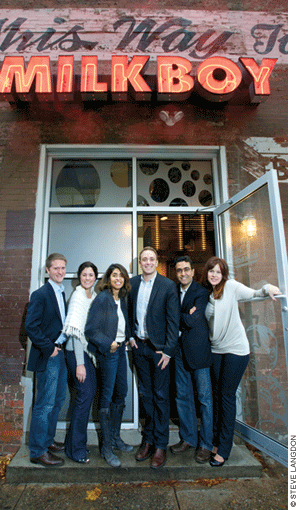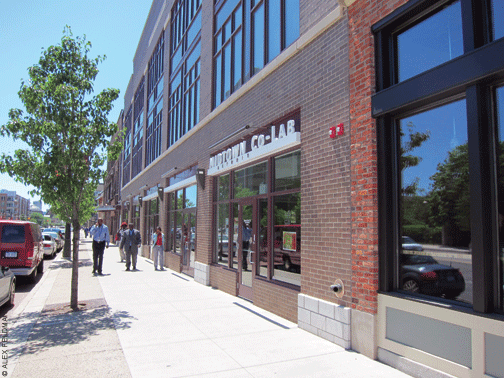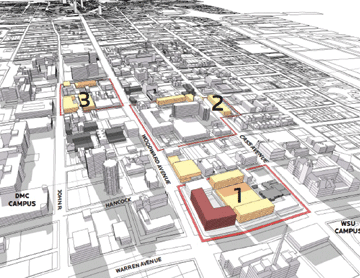
Multiple Classes | Near the end of his nine-year tenure as Penn’s chief planning and real-estate officer, Omar Blaik found himself hosting an increasing number of visitors from other universities, cities, and states.
“They would ask us, ‘How do you do this?’” says Blaik. “And we would say, ‘We’re translators. We translate how higher education works to the private sector and to the real-estate market. And we translate the real-estate market to the higher-education decision-makers.’”
That notion is at the heart of what Blaik continues to do today at University City-based U3 Ventures (u3ventures.com), the boutique real-estate and planning consulting firm that he founded in 2006 and serves as president. Everyone at the five-person firm has Penn ties. Lisa Prasad G’88 GFA’88, U3’s principal, worked with Blaik as an associate vice president in Penn’s facilities and real-estate services division, while associates Alex Feldman C’05 GAr’08 GFA’08, Jaime Flaherty GCP’05, and George Smith GCP’07 have, in addition to their Penn degrees, first-hand knowledge of the issues and challenges facing West Philadelphia and other urban areas. (Feldman, for example, recently worked with the American University of Beirut to find affordable housing near campus for faculty and staff, and before that worked on large-scale master-planning and design projects in Moscow, Abu Dhabi, Boston, and Hong Kong during his stints at Kohn Pedersen Fox Architects in London and New York. Flaherty and Smith are developing a real-estate strategy for the University of Maryland.) Together they leverage alliances between town and gown to recommend and implement creative urban-planning solutions for eight to 10 clients at a time.
These days all five are working on some aspect of U3’s biggest and best-known project—the revival of Midtown Detroit.
“Over the past year or so,” says Blaik, “our story—the U3 Ventures story—has become known as the Detroit story, not the West Philadelphia story.”

Blaik’s willingness to take on Detroit, arguably the poster child for an urban area in freefall, is not surprising. In 1998, during the earliest phase of West Philadelphia’s transformation, the Cairo native was the first Penn administrator of the era to personally invest in that neighborhood, moving his family from New York and into a six-bedroom Victorian twin at 46th Street and Baltimore Avenue.
During his tenure Blaik oversaw construction and real-estate activities in excess of $2 billion, including the founding of the Penn Alexander School and the growth of 40th Street into a lively corridor—two hard-won accomplishments that helped transform University City from a sometimes-dangerous and commercially enervated area to one that is vibrant, vital, and far less violent. When he stepped down in 2006, Inga Saffron, The Philadelphia Inquirer’s architecture critic, called him “the closest thing Philadelphia had to a planning visionary.”
By then the notion of translation had crystallized, and Blaik had begun to envision an independent venture: a planning firm with higher-education experience.
“You cannot tread lightly in this space,” Blaik says. “Either you’ve been inside it and you know exactly how it works, and you know what the strategies and the interventions are, or you can’t be effective.”
Detroit’s philanthropic community contacted Blaik and his U3 colleagues based on his and Prasad’s work at Penn. The community was looking for a way to leverage Midtown Detroit’s remaining institutions—Wayne State University, Detroit Medical Center, and the Henry Ford Health System—for greater economic impact. Using their knowledge of what had worked at Penn, U3’s team members identified a number of opportunities.
The ensuing interventions included incentives to encourage employees and students to live locally and to buy goods and services from Detroit-based businesses. Further incentives prompted businesses to hire more city residents and to create an innovation network to commercialize the technologies and research coming out of those institutions—and to transform the decimated manufacturing-based economy into a knowledge-based one.
As a result, $40 to $50 million of investment has poured into Detroit’s Midtown. Whole Foods, downtown Detroit’s first national supermarket chain, broke ground last spring. U3’s Live Local incentives brought more than 200 new families into Midtown in a few months, and the rental-housing vacancy rate in the neighborhood is now less than two percent. The retail and restaurant scenes are burgeoning.

“You drive through Midtown,” says Blaik, “and you see construction happening.”
The Greater Downtown area has started to implement similar programs. Michigan’s governor, who mentioned U3’s work in his 2011 State of the State address, has shown interest in executing such strategies in five other cities across the state.
In the end, Detroit was an ideal canvas for U3.
“There’s a tremendous opportunity in Detroit to build something new because everything old is questionable,” says Prasad. “If you spend time there and get beyond all of the city politics and you get beyond the crumbling buildings, there’s a tremendous opportunity to rebuild an urban center.”
When Penn’s School of Design sends graduating students to Blaik for advice on where they should go, he tells them, “If you really want to be on the cutting edge of urban policy and urban planning, go to Detroit—because that’s where they are comfortable with experimentation.
“In a funny way that’s what attracted us there,” he adds. “We felt that if we can make a difference there, we can make a difference anywhere.”
—Caroline Tiger C’96

